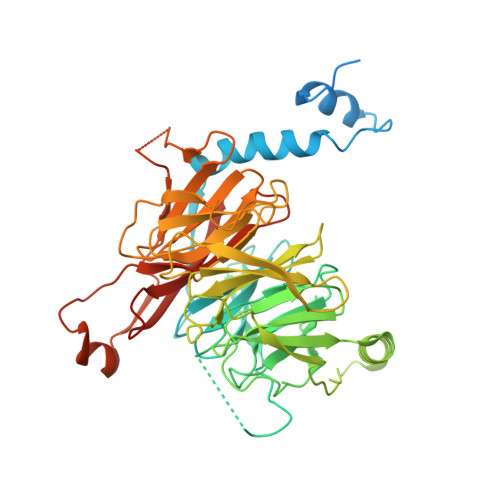Recognition of the CCT5 di-Glu degron by CRL4 DCAF12 is dependent on TRiC assembly.
Pla-Prats, C., Cavadini, S., Kempf, G., Thoma, N.H.(2023) EMBO J 42: e112253-e112253
- PubMed: 36715408
- DOI: https://doi.org/10.15252/embj.2022112253
- Primary Citation of Related Structures:
8AJM, 8AJN, 8AJO - PubMed Abstract:
Assembly Quality Control (AQC) E3 ubiquitin ligases target incomplete or incorrectly assembled protein complexes for degradation. The CUL4-RBX1-DDB1-DCAF12 (CRL4 DCAF12 ) E3 ligase preferentially ubiquitinates proteins that carry a C-terminal double glutamate (di-Glu) motif. Reported CRL4 DCAF12 di-Glu-containing substrates include CCT5, a subunit of the TRiC chaperonin. How DCAF12 engages its substrates and the functional relationship between CRL4 DCAF12 and CCT5/TRiC is currently unknown. Here, we present the cryo-EM structure of the DDB1-DCAF12-CCT5 complex at 2.8 Å resolution. DCAF12 serves as a canonical WD40 DCAF substrate receptor and uses a positively charged pocket at the center of the β-propeller to bind the C-terminus of CCT5. DCAF12 specifically reads out the CCT5 di-Glu side chains, and contacts other visible degron amino acids through Van der Waals interactions. The CCT5 C-terminus is inaccessible in an assembled TRiC complex, and functional assays demonstrate that DCAF12 binds and ubiquitinates monomeric CCT5, but not CCT5 assembled into TRiC. Our biochemical and structural results suggest a previously unknown role for the CRL4 DCAF12 E3 ligase in overseeing the assembly of a key cellular complex.
Organizational Affiliation:
Friedrich Miescher Institute for Biomedical Research, Basel, Switzerland.
















